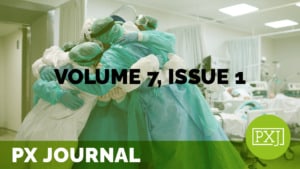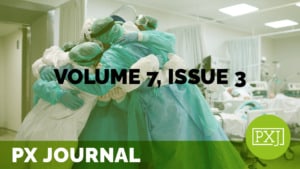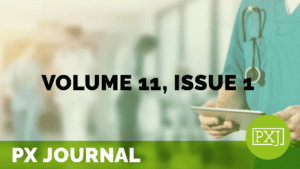PXJ Article
Showing 129–144 of 563 results
-
 Innovation & Technology
Innovation & TechnologyDeveloping a patient satisfaction measure for imaging-based patient information during clinical consultations
Learn more -
 Patient Family & Community Engagement
Patient Family & Community EngagementDeveloping approaches to the collection and use of evidence of patient experience below the level of national surveys
Learn more -
 Policy & Measurement
Policy & MeasurementDeveloping the first pan-Canadian acute care patient experiences survey
Learn more -
 Policy & Measurement
Policy & MeasurementDevelopment and reliability of a patient experience inventory tool for hospitals
Learn more -
 Policy & Measurement
Policy & MeasurementDevelopment of an experienced quality measure for clients, informal and formal caregivers in home care in the Netherlands: A participatory action research
To optimise home care provision and to identify potential improvements in the care process, it is important to gain insight into the care experiences that influence care quality. The aim was to develop a qualitative experienced quality measure for home care in The Netherlands, facilitating conversations between clients and caregivers in generating possible points of
Learn more -
 Innovation & Technology
Innovation & TechnologyDigital patient engagement at a perioperative surgical home implemented community hospital
Learn more -
 Patient Family & Community Engagement
Patient Family & Community EngagementDoes an empathic pre-visit conversation with another team member improve perceived surgeon empathy?
Learn more -
 Patient Family & Community Engagement
Patient Family & Community EngagementDoes Patient Experience Change with Age? Exploring Associations Between Patient Experience, Gender and Age
Patient experience measurement is important for healthcare organizations to support the provision of high-quality care. Although previous research suggests age and gender may influence patient experiences, a thorough analysis of these associations remains unexplored. To address this gap, our research investigates the association of age and gender on patient experience ratings, using data from two
Learn more -
 Culture & Leadership
Culture & LeadershipDoes she think she’s supported? Maternal perceptions of their experiences in the neonatal intensive care unit
Learn more -
 Environment & Hospitality
Environment & HospitalityDoes the use of volunteers and playbooks in pediatric primary care clinic waiting rooms influence patient experience?
Learn more -
 Innovation & Technology
Innovation & TechnologyDraws and windfalls: Comparing patient experiences in inpatient telehealth and non-telehealth acute care units
The global COVID-19 pandemic has challenged health care delivery in many ways. One solution from the pandemic that offers potential upside is the expansion of telehealth as a means to provide high quality, cost-effective, and safe care while also maintaining excellence in patient and family experience. While most examinations of the use of telehealth over
Learn more -
 Patient Family & Community Engagement
Patient Family & Community EngagementDriving Healthy Behaviors through Social Support: The Role of Co-Responsibility in Weight Loss and Maintenance
The effectiveness of out of hospital lifestyle interventions in healthcare is likely co-dependent on social support from involved one’s. We sought to investigate the interrelationships between patient-partner Co-responsibility, Spousal Support, and Self-efficacy and the mechanisms through which they contribute to health behaviors and outcomes relevant to weight loss and maintenance.
Learn more -
 Staff & Provider Engagement
Staff & Provider EngagementDyad rounding on inpatients admitted from Emergency Department: Rehumanizing the patient & clinician experience in a post pandemic world
Emergency departments (ED) across the country were stretched to the breaking point as a result of the COVID-19 pandemic. The chaos, fear, and uncertainty impacted the emotional, physical, and spiritual well-being of not only the patients and families but also nurses, providers, and the myriad of other clinical and non-clinical staff providing care in the
Learn more -
 Policy & Measurement
Policy & MeasurementEffect of change in the CG CAHPS survey instrument recall period on patient experience scores on healthcare utilization
Learn more -
 Staff & Provider Engagement
Staff & Provider EngagementEffect of wearing masks in the hospital on patient-provider interaction: “They (providers) need to stay safe for their family and keep us safe.”
Since March 2020 when the Severe Acute Respiratory Syndrome Coronavirus 2 (SARS-CoV-2) pandemic was widespread in the U.S., masks became a primary form of protection for healthcare workers when caring for patients. While wearing masks was not a new phenomenon in the health field, there is little known on how the use of them affects
Learn more -
 Quality & Clinical Excellence
Quality & Clinical ExcellenceEffectiveness of Incident Reporting Tools in Ensuring Patient Safety: A Systematic-Narrative Hybrid Review
Background: Ensuring Patient Safety in healthcare is essential and requires efficient methods to reduce risks and improve the quality of care. Although incident reporting tools are commonly used to identify possible and actual care failures, their efficacy differs among various environments. The aim is to evaluate the effectiveness of incident reporting tools in enhancing patient safety. Methods: This
Learn more